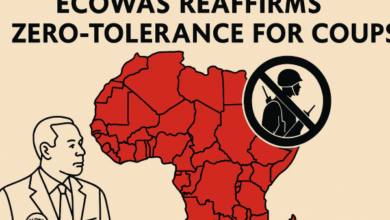Iran’s Indirect Death Threat Against Trump: A Dangerous Escalation in Rhetoric

In a worrying development that underscores the fragile fault lines of U.S.-Iran relations, Iran has indirectly issued what many interpret as a religiously framed death threat against former U.S. President Donald Trump. This comes in response to Trump’s recent comments suggesting that Iran’s Supreme Leader, Ayatollah Ali Khamenei, remains a potential military target.
While Trump’s statement — “We are not going to take him out, at least not for now” — may have been delivered with political bravado, the Iranian response has taken a decidedly more ominous tone. Ayatollah Nasser Makarem Shirazi, a powerful cleric based in Qom and known for his influence within Iran’s theocratic establishment, issued a fatwa-like declaration that threats against Khamenei are a sin punishable by death under Islamic law.
The Clerical Decree and Its Implications
Though Shirazi did not explicitly name Trump, his statement — reported by Iran’s state news agency IRNA — was a direct theological response to a question regarding the former U.S. president’s threat. He invoked the Islamic concept of “Moharebeh”, referring to individuals deemed enemies of God. Under Iranian law and Shia Islamic tradition, this label can carry the death penalty.
This religious framing serves multiple functions:
- Legitimizing Retaliation: By invoking Moharebeh, Shirazi is effectively authorizing, in religious terms, retaliation against perceived enemies, including foreign political figures.
- Mobilizing Extremist Sentiment: Such pronouncements can inflame extremist elements or proxy actors in the region, especially in places like Iraq, Syria, or Lebanon where Iran wields significant influence.
- Sending a Signal to the West: It’s a strategic message to Washington and its allies that Iran’s leadership — both political and clerical — is prepared to defend Khamenei with theological and potentially military force.
Repercussions for U.S.-Iran Relations
This indirect threat comes against the backdrop of ongoing tensions over nuclear negotiations, regional proxy conflicts, and Trump’s ordered drone strike that killed General Qassem Soleimani in 2020. That event remains a festering wound in Iran’s political memory and has fueled repeated vows of vengeance.
The Iranian regime may be testing boundaries with such declarations:
- Domestic Posturing: Bolstering its hardline credentials at home by appearing resolute against foreign threats.
- International Signaling: Warning both the Biden administration and potential future Trump-led administration of the risks of escalatory rhetoric.
Washington’s Likely Response
So far, the U.S. has not officially responded, but the security establishment will almost certainly treat the cleric’s words as a credible incitement — especially given past incidents of Iranian-backed plots targeting U.S. citizens and officials.
The U.S. Secret Service and intelligence agencies are likely on high alert, particularly with the 2024 elections looming and Trump remaining a polarizing but dominant figure in American politics.
Conclusion
While the threat remains indirect, its religious undertones give it dangerous weight in the Middle East’s volatile ideological ecosystem. For the international community, this highlights the peril of escalating rhetoric between nuclear-ambitious Iran and a politically divided America.
For investors and global businesses, it’s a reminder that geopolitical risk in the Gulf remains a live wire — and that the intersection of theology and diplomacy in Iran can have very real-world consequences.
BRANDECONOMY INSIGHT:
The fusion of faith-based decrees with geopolitical grievances elevates this from mere posturing to a serious potential security threat. Stakeholders in oil markets, defense contracts, Middle Eastern diplomacy, and global risk management should take note.










